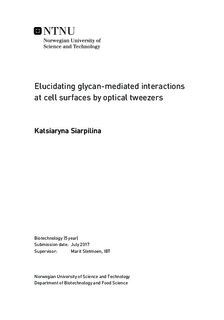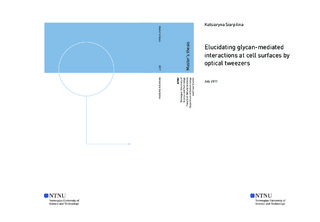| dc.description.abstract | In this study, carbohydrate-interactions were investigated by using optical tweezers, which is an instrument for the measurement of forces down to 0.1 pN. Carbohydrates are added to various biological polymers in a process called glycosylation. Glycosylation is the covalent attachment of sugar-chains to proteins and lipids. The huge diversity makes these sugars well suited for cell-recognition. During carcinogenesis, the cells often express much shorter glycans on its surface molecules, which are known as as tumour-associated cancer antigens (TACAs). MUC1 is a surface protein that has an upregulated expression in cancer cells, with the appearance of TACAs like Tn, T, STn and ST. The functions of the antigens are unknown, but the expression of Tn and STn correlates with poor prognosis. This study aimed to investigate how all of the aforementioned antigens interact by using optical tweezers, to attempt to find out whether some of these glycans can be able to modulate the interactions at cell surfaces.
It was found MUC1-Tn, MUC1-STn and MUC1-ST all were able to bind to themselves and each other. The strength of the forces between MUC1-Tn - self and MUC1-STn - self antigens seemed to be of equal strength, but that MUC1-STn experienced interactions more frequently. MUC1-T was also able to self-interact, but was not found to bind the other mucins. This might be due to experimental difficulties, and it would be adviseable to repeat the experiments for this mucin. It was found that GalNAc, had a central role in the interactions. The N-acetyl group of the sugar appears to be important. A more heavily glycosylated mucin, TR-PSM-H8, was investigated. This was a normally glycosylated mucin. It was found that, at the loading rates measured, the TR-PSM-H8 mucin exhibited unbinding forces about twice as high as those found for MUC1-Tn - self and MUC1-STn - self.
%that MUC1-Tn and MUC1-STn could self-associate, and also bind to MUC1-ST. It seemed like the forces between these antigens were the same, but that MUC1-STn experienced interactions more frequently than MUC1-Tn. On the contrary, MUC1-T was found to rarely associate with any of the mucins or itself. MUC1-ST was found to have rare, and also weak self-interactions. It was found that GalNAc, had a central role in the interactions. The N-acetyl group of the sugar appears to be important. A more heavily glycosylated mucin, TR-PSM-H8, was investigated. This type of mucin had a glycosylation pattern similar to what can be found on healthy cells. It was found that, at the loading rates measured, the TR-PSM-H8 mucin exhibited unbinding forces about twice as high as those found for MUC1-Tn - self and MUC1-STn - self.
Lectins are proteins that can bind to sugar moieties and mediate a cell's response to them. Macrophage galactose type C-type lectin (MGL) is a receptor-protein that can be found only on dendritic cells and macrophages, which are antigen-presenting cells. MGL has been of interest in the development of cancer vaccines, as it is believed that its efficient activation can create a response against TACAs. It was confirmed that MGL was able to bind to MUC1-Tn, in the absense of calcium. It was not found to bind a polyacrylic acid backbone with 80\% Tn.
%, but it did not seem to be able too bind to a polyacrylic acid backbone with 80\% Tn. It has previously been found that the affinity of MGL to PAA-GalNAc increased as the substitution of GalNAc increased.
Optical tweezers were used to investigate the interactions between a mycotoxin - fumonicin B1, and the surface glycans on yeast cells. Fumonisin is a carcinogen that can contaminate food such as wheat, oat, and corn and grapes. As fumonisin can appear in wine, which already has yeast, a yeast-system was tested for interactions with fumonisin. The yeast cell wall consists of an inner layer of chitin, a middle layer of ${\beta}$-glucan, and an outer coating of mannan. It was found that fumonisin interacted strongly with components laminarin (${\beta}$-glucan) and chitosan, respectively, but not with the mannan. The mannan also seemed to protect whole yeast cells from fumonsin. Thus, to be able to use a yeast system for the removal of fumonisin, it could be important to remove the mannan-layer, or potentially, use cell-fragments of yeast instead. | |

